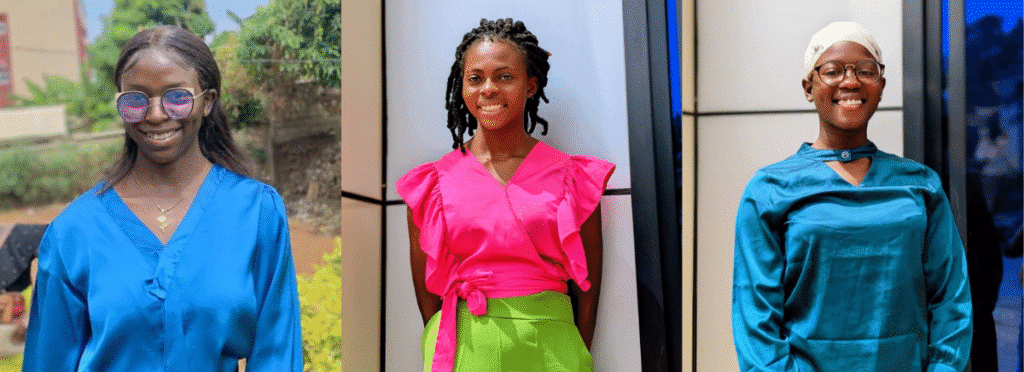Unique Contributions of Women in Medical Physics and Biomedical Engineering

Authors of Unique Contributions of Women in Medical Physics and Biomedical Engineering.
Left to right. Mezoh Tracy Penn, Pieranne Mankaa, and Jasmine Njimbong.
Background
Medical device development can be traced back through medical physics and Biomedical Engineering (Beckers et al, 2021). Medical physicist experts tackle healthcare’s most complex challenges, and the contributions of women here are invaluable. Despite persistent discrimination, women have demonstrated excellence and innovation in these fields. Yet women are not celebrated as they should, contributing to gender inequity and discouraging other female biomedical engineers (Szczesny et al, 2025).
Aim
This research aims to address this gap and promote gender equity by documenting and highlighting the unique contributions of women in Medical Physics and Biomedical Engineering, shout out to every hero and encourage women taking a part in medical device development.
Methods
Employing a mixed-methods approach, this study combines historical analysis of archival materials and literature with contemporary data gathered through books, articles and journals, especially those written by women working in this field. These materials will reveal the historical context of women’s involvement in medical physics and biomedical engineering and provide qualitative insights into their experiences, challenges, and successes.
Results
The research will also spotlight innovative developments led by women and their impact on patient care, technological advancements, and gender relations. The expected results of this research will include a collection of case studies, testimonials, and statistical data showcasing the diverse and impactful contributions of women. This research seeks to foster a more equitable environment, inspire future generations of women who want to pursue careers in these vital fields, and ensure that their contributions are recognized and celebrated.
Chapter 1: Introduction
Biomedical Engineering and medical physics are ever-evolving fields that play a crucial role in healthcare and medicine. They combine engineering principles with biological and medical sciences to create innovative solutions that enhance medical treatments and patient outcomes. According to Phyllis Hanlon in 2015, women possess 3 important characteristics: the ability to listen, empathy/ability to understand someone else’s point of view, and teamwork which makes them uniquely suited to tackle the complexities of these fields. Women’s perspectives are particularly crucial in developing technologies and solutions that cater to the diverse needs of all patients. Their ideas are vital for addressing gender-specific health challenges and ensuring that critical areas like breast cancer research and reproductive health receive the attention they deserve (Admin, 2025). By exploring their contributions, addressing the barriers they face, and highlighting the impact they’ve created, we aim to inspire more women to join these fields and shape the future of healthcare. This article presents an in-depth of the unique contributions of women in Medical Physics and biomedical engineering, the barriers and challenges they face, the impact they’ve created, more about biomedical engineering today and the future for women in BME today.
CHAPTER 2: Contributions of women
This chapter presents the contributions made by women to Medical Physics and Biomedical Engineering. Through a review of articles and websites, we’ll look at some discoveries and innovations made by women in these fields.
2.1. Historical Contributions
Throughout history, women have been making significant contributions despite the numerous challenges they face in medical physics and Biomedical Engineering. They have improved medical device development, radiation therapy, and discovered many techniques that improve health care. Here are some great women who have contributed greatly in medical physics and Biomedical Engineering (Buntz, 2016).
- Marie Curie: Marie Curie with the help of her husband Pierre, Marie Curie discovered radium and polonium and helped lay the groundwork for the development of the x-ray and to cancer treatments.
- Rosalyn Yalow: Yalow, a medical physicist, partnered with Solomon Berson to invent the radioimmunoassay. The technique ultimately found use in identifying viruses such as hepatitis in blood banks and was also used to calculate optimal drug doses.
3- Rosalind Franklin: Rosalind Franklin discovered the structure of DNA.
4- Letitia Geer: Letitia discovered the modern medical syringe in 1899. Before her invention, syringes had to be operated with two hands.
5- Ida Henrietta Hyde: Ida Henrietta Hyde invented the microelectrode in the 1930s.
6- Flossie Wong-Staal: Flossie Wong StaalWong-Staal helped discover the HIV and mapped its genes by cloning the virus in 1985. That accomplishment led to the development of a genetic map of the virus, which paved the way for blood tests for HIV.
7- Patricia Bath: In 1986, Patricia Bath invented the Laserphaco Probe system for removing cataracts–a laser-based system that made removal of cataracts more accurate and less painful.
2.2. Contemporary Contributions
From the past year, women still continue to make significant advancements in medical physics and biomedical engineering, with their main focus on areas like cancer diagnosis and treatment, and advanced imaging techniques.
Dr. Michela Esposito, a researcher at UCL, has brought the phase-contrast imaging technique for the diagnosis and treatment of cancer and is currently working on a new imaging techniques for x-ray microscopy.
Dr. Blumberg and her team at Yale School of Medicine, with the use of MRI scans have revealed sex-specific differences in the brain’s response to childhood maltreatment, which explains why females are more likely to develop depression after maltreatment (Anjali Sankar, 2025).
Dr. Aisha N. Bismillah is currently working on a supramolecular host for drug delivery.
Chapter 3: Women in Medical Physics and Biomedical Engineering: Breaking
Barriers, Impact, and the Road Ahead
3.1 Breaking Barriers and Challenges
Historically, women entering the fields of medical physics and biomedical engineering have encountered systemic and structural barriers ranging from limited access to education and mentorship to entrenched gender biases in hiring, promotion, and research funding. These challenges have been particularly acute in low- and middle-income countries (LMICs), where infrastructural limitations and cultural norms further restrict female participation in STEM (World Health Organization [WHO], 2021).
Despite these hurdles, women have persistently broken ground. The foundational contributions of figures like Marie Curie helped establish a legacy that has inspired generations of women in radiological sciences. In more recent decades, global and regional advocacy efforts have sought to increase visibility and support for women in these disciplines. Notable among them are the Women Subcommittee of the International Organization for Medical Physics (IOMP) and the Women in Biomedical Engineering Working Group under the International Federation for Medical and Biological Engineering (IFMBE), which champion equity-focused policies, mentorship opportunities, and leadership pipelines (IOMP, 2022; IFMBE, 2021).
Nevertheless, challenges persist. A global survey by the International Union for Physical and Engineering Sciences in Medicine (IUPESM) highlights that while female participation is growing, women remain underrepresented in senior and decision-making roles. Additionally, studies report that many women in these fields experience lower confidence in their technical abilities, a reflection of societal biases rather than skill deficits (Wang et al., 2020). These factors collectively contribute to a leaky pipeline where women often exit the profession at higher rates than men.
3.2 Impact and Future Directions
Despite underrepresentation, women have had a profound and growing impact on both medical physics and biomedical engineering. In medical physics, female scientists have been instrumental in refining radiotherapy protocols, advancing dosimetry standards, and promoting
patient safety initiatives. In biomedical engineering, women have led innovations in wearable technologies, brain-computer interfaces, biosensors, and maternal health monitoring systems (Subramanian et al., 2023; Neufeld et al., 2019).
Moreover, the involvement of women in interdisciplinary research has introduced more inclusive, user-centered design paradigms. Their leadership in global health technologies has enhanced the accessibility and adaptability of medical devices in underserved regions. These contributions underscore the importance of diverse perspectives in driving equitable healthcare solutions (Bakken et al., 2016).
Looking ahead, the path forward is promising but demands intentional action. Global initiatives such as the WHO’s Gender Equality in Health Workforce strategy and UNESCO’s STEM and Gender Advancement (SAGA) program aim to remove institutional barriers and create enabling environments for women in STEM fields (WHO, 2021; UNESCO, 2022). Priorities for the future include:
– Digital health leadership: Women are spearheading developments in AI-driven diagnostics and mobile health platforms.
– Equity-driven innovation: Increasing efforts to eliminate gender bias in clinical trials, datasets, and algorithm design.
– STEM education reform: Integrating biomedical and health engineering into school curricula with a focus on gender inclusion.
Mentorship, equitable grant access, and the elevDespite underrepresentation, women have had a profound and growing impact on both medical physics and biomedical engineering. In medical physics, female scientists have been instrumental in refining radiotherapy protocols, advancing dosimetry standards, and promoting
patient safety initiatives. In biomedical engineering, women have led innovations in wearable technologies, brain-computer interfaces, biosensors, and maternal health monitoring systems (Subramanian et al., 2023; Neufeld et al., 2019).
Moreover, the involvement of women in interdisciplinary research has introduced more inclusive, user-centred design paradigms. Their leadership in global health technologies has enhanced the accessibility and adaptability of medical devices in underserved regions. These contributions underscore the importance of diverse perspectives in driving equitable healthcare solutions (Bakken et al., 2016).
Looking ahead, the path forward is promising but demands intentional action. Global initiatives such as the WHO’s Gender Equality in Health Workforce strategy and UNESCO’s STEM and Gender Advancement (SAGA) program aim to remove institutional barriers and create enabling environments for women in STEM fields (WHO, 2021; UNESCO, 2022). Priorities for the future include:
- Digital health leadership: Women are spearheading developments in AI-driven diagnostics and mobile health platforms.
- Equity-driven innovation: Increasing efforts to eliminate gender bias in clinical trials, datasets, and algorithm design.
- STEM education reform: Integrating biomedical and health engineering into school curricula with a focus on gender inclusion.
Mentorship, equitable grant access, and the elevation of role models will be central to sustaining momentum and driving structural change.
3.3 Biomedical Engineering Today: A Gendered Perspective
Biomedical engineering today is a rapidly evolving field that blends the precision of engineering with the compassion and complexity of human-centred healthcare. It spans applications from tissue engineering and rehabilitation robotics to telehealth and health systems optimization. Women are increasingly influencing how this field is conceptualized and practiced—not only
through technical innovation but also by embedding values of equity, usability, and social responsibility into design processes (Yazdani & Rotondi, 2020).
At the undergraduate level, female enrolment in biomedical engineering programs has approached gender parity in many regions. However, a stark contrast exists at the faculty and leadership levels. A 2023 analysis revealed that between 2001 and 2021, women accounted for only 15–27% of biomedical engineering faculty, and at the current rate of progress, full parity may not be achieved before 2067 (Frontiers in Neuroscience, 2023). Furthermore, women remain underrepresented in journal editorial boards, grant review panels, and top-tier research roles.
In medical physics, similar trends are evident. A 2024 review identified persistent gaps in the appointment of women to senior roles and leadership committees, indicating that systemic challenges continue to shape career trajectories in subtle but significant ways (International Journal of Radiation Oncology, Biology, Physics, 2024).
Nonetheless, the landscape is changing. From women-led biomedical startups in Africa and Asia to global consortia directed by female professors in regenerative medicine, visibility and recognition are increasing. These examples reflect a broader shift in how biomedical engineering is being redefined—not just as a technical field but as a transformative force that must prioritize inclusion.
In moving forward, biomedical engineering must treat equity not as an optional consideration but as a core design principle. By doing so, the field will be better equipped to address the full spectrum of human health needs and to reflect the diversity of the populations it serves.
CONCLUSION
The future of women in clinical engineering is bright and rapidly evolving. Startups such as Med Techies Cameroon exemplify the new wave of women-led initiatives transforming the landscape. Alongside similar groups and global networks, women-led organizations are nurturing a generation of female innovators who are not only designing cutting-edge medical technologies but also ensuring their relevance to diverse populations and health challenges.
Women are increasingly at the forefront of digital health, artificial intelligence, and equity-driven innovation. Their leadership is crucial in addressing gender-specific health needs, eliminating bias in medical device development, and making healthcare more accessible in underserved regions. As more women enter and lead within the field, clinical engineering will continue to evolve into a discipline that values inclusion, usability, and social responsibility, ultimately improving patient outcomes worldwide (Yazdani & Rotondi, 2020; UNESCO, 2022).
A Glimpse of Light: The Way Forward
To reach this promising future, intentional and sustained action is essential. People supporting women to thrive in healthcare technology are called to:
Expand Mentorship and Networking, Promote Gender-Inclusive Education, Champion Equity in Research and Leadership, Celebrate Role Models and Success Stories and Foster Innovation for All Strengthen programs that connect women at all career stages, providing support, guidance, and opportunities for leadership development.
This can be done by integrating biomedical engineering into school curricula with a focus on gender equity, ensuring girls and young women are encouraged to pursue STEM careers from an early age. Advocating for fair access to research funding, leadership positions, and decision-making roles, addressing structural barriers that hinder women’s advancement can only make it easier.
We look forward to a clinical engineering community where women do not only participate but lead, innovate, and transform healthcare for everyone. This is our glimpse of light-a vision of a more inclusive, equitable, and impactful field, guided by the brilliance and determination of women in clinical engineering (Admin, 2025; IFMBE, 2021; WHO, 2021).

Left to right. Mezoh Tracy Penn, Pieranne Mankaa, and Jasmine Njimbong.
References
Admin. (2025, January 19). Empowering Women in Biomedical Engineering: Breaking Barriers and Building
Futures. Connect Biomedical, 7.
Anjali Sankar, X. S. (2025, February 12).
PREDICTING DEPRESSED AND ELEVATED MOOD SYMPTOMALOGY IN BIPOLAR DISORDER USING BRAIN FUNCTIONAL CONNECTOMES. Retrieved from National Library of Medicine.
Buntz, B. (2016, March 23). MEDICAL DEVICE AND DIAGNOSTIC INDUSTRY. Retrieved from 10 of Medtech’s
Greatest Women Medtech Innovators.
Leon, D. (2023). Engineering Solutions for Medicine: The Role of Biomedical Engineers in Transforming
Healthcare. Journal of Bioengineering and Biomedical Science, 13(2).
Niroomand-Rad, A. (2023). History of Pioneer Women in Medical Physics. MEDICAL PHYSICS INTERNATIONAL,
- Retrieved from History of Pioneer Women in Medical Physics.
Bakken, S., Grullon-Figueroa, L., Izquierdo, R., Lee, N. J., Morin, P., Palmas, W., & Teresi, J. (2016). IDEATel project: Women’s leadership in health informatics research. Journal of Biomedical Informatics, 63, 126–134. https://doi.org/10.1016/j.jbi.2016.07.006
Frontiers in Neuroscience. (2023). Gender parity in BME faculty positions may not be achieved until 2067.
Frontiers in Neuroscience, 17, 1104419. https://doi.org/10.3389/fnins.2023.1104419
IFMBE. (2021). Women in Biomedical Engineering Working Group. International Federation for Medical and
Biological Engineering. https://ifmbe.org
IOMP. (2022). Women Subcommittee Annual Report. International Organization for Medical Physics. https://www.iomp.org
International Journal of Radiation Oncology, Biology, Physics. (2024). Gender disparities in medical physics: A current assessment. IJROBP, 118(1), 113–120. https://doi.org/10.1016/j.ijrobp.2024.03.016
Neufeld, E., Chavannes, N., & Kuster, N. (2019). Female leadership in neurotechnology and neuroethics: Advances and challenges. Frontiers in Neuroscience, 13, 512. https://doi.org/10.3389/fnins.2019.00512
Subramanian, K., Thomas, A., & Bello, K. (2023). Women innovators in wearable technology: Bridging maternal health gaps. IEEE Journal of Biomedical and Health Informatics, 27(2), 331–339. https://doi.org/10.1109/JBHI.2023.3248127




Responses